Mandragoran Reading
To cast this spell a spellcaster must have the Increased Spell Capacity feat and be able to cast 9th level arcane spells. While the spell will probably usually be administered with the subjects consent, a successful Will Save made when the spell is cast will negate the affect of the spell..
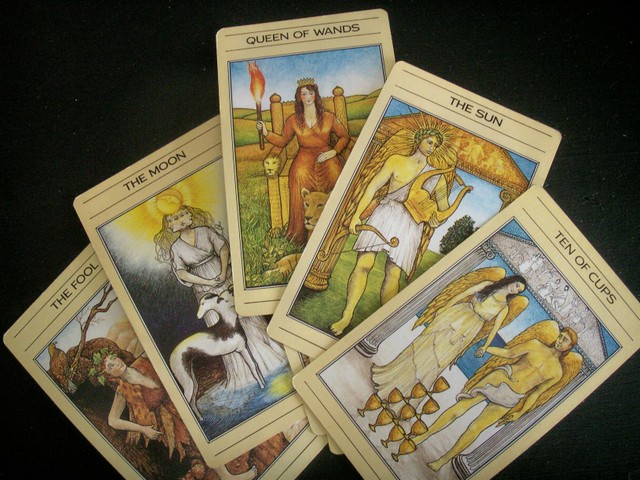
Mandragoran Reading
10th level spell
Durration: 1 minute (10 rounds)
Saving Throw: Will negates
Spell Resistence: Yes
Casting Time: 1 action plus the 1 minute durration.
Components: V, S, M (Deck of Many Things or Tarot Deck)
The Mandragoran Reader shuffles a Deck of Many Things, or a Tarot Deck, and the deck is layed in front of the target creature. The target creature may choose to make a normal will save to resist cutting the deck. If their save succeeds and they choose not to touch the cards, the spell ends with no other effect. If they touch the cards, they must cut the deck, at which point for the next minute (10 rounds) they can do nothing but await the rest of the reading. Any attacks made on the target will immediately end the spell and free him of his transfixation. The spell does provide a minimal protection from external attacks for both the reader and the target. An invisible forcefield, similar to a wall of force but taken down only by a remove curse (or similar fate canceling magic) surounds the two in a five foot radius while the reading takes place. The target creature draws 5 cards and places them face down as directed by the Mandragoran Reader. As soon as the cards are drawn, but not before, the Reader is aware of their identity even though the target (now called the "Subject") does not. When all five cards are on the table the Reader tells the Subject in which of the five positions to place each card. The five positions are: The Past, The Past in the Present, The Card that is the Subject, the Card that Crosses, and the Future and they are layed as such:
"The Mandragoran Lay"
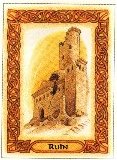 1. The Past |  5. The Future | |
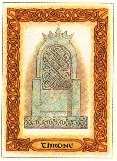 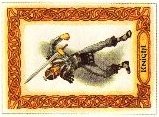 3. The Card that is the Subject 4. The Card That Crosses | ||
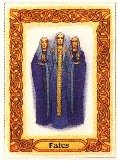 2. The Past In The Present |
In the Order They Are Revealed:
The Past, this is the first card that is revealed. It represents the past of the subject character and will become a point of focus for the spell. The card that is revealed must be related to some past event in the subjects history - if it is the Dungeon, it relates to some time that the subject was imprissoned, if the Comet, it relates to some past enemy that the subject defeated and grew stronger by, if the gem, a particular magical item that was a part of the creatures past. The casting of this spell allows the Mandragoran Reader to learn enough knowledge about the subject to select an appropriate event. Once this card is Interpreted the rest of the reading is keyed to that event.
The Past In The Present: When this card is turned it becomes connected to the specified past event and represents the status of that event (those enemies, that item, etc) in this time. For example, in lorocus's reading, if the first card that was turned was the Dungeon, and it was related to Lorocus having been imprissoned by the Githyanky, this card could be interpreted to represent the githyanky at this time. Thus, if the "key" (gain a powerful weapon) was in this possition, it might be Interpreted that a powerful weapon was created or aquired by the githyanky. This spell is a manifestation of Observer (or Interpreter) Created Reality, and similar to an Alter Reality spell, it may contain a experience point cost. While the Mandragoran Reader may Interpret the card, the DM can apply an experience point cost as appropriate.
The Card That Is The Subject.
Uncovering this card has no
immediate effect, it simply represents the character. If this card is ever
drawn from another deck randomly by the subject, the subject gains either
double the effect or his choice of another card effect in that deck. i.e. for
Lorocus, if the Card that is the Subject is the "Hierophant" in this
reading, it becomes 'his card' and at some point in the future he comes across
a deck of many things and happens to randomly draw the Heirophant, he could choose
to gain a level after defeating his next monster. Good luck! For the
Mandragoran Reading, however, the card that is placed here is interpreted to
relate to some skill or power that the subject has and that relationship is
read from the flavor of the card. For example, if the card is the
"Moon" (granted 1-4 wishes) it could be related to an at will power
the character posseses, if the Idiot (lose intelligence) it could be related to
the characters intelligence or an
intelligence based skill such as spellcraft, etc.
The Card that Crosses:
This is a very special possition. The
card in this position is what links the Past In The Present with the character
himself. It can represent a new fate strand that has crossed the the Subject's
own. The Mandragoran Reader may either choose to visit the card effect on the
subject at the end of the reading or just use the card to interpret the link.
The Card That Crosses must represent an item, place, or entity that is already
in existence. Again, the Mandragoran Reader has access to a legend Lore for
purposes of gaining details. Only a minimal amount of reality shaping may
be done here with the appropriate experience point cost. For example, in
Lorocus's reading, if the card is the "Rogue", (a friend turns against
you) the Mandragoran reader could say that Grak Demontooth has betrayed you to
them and it is his machinations that will bring the githyanky and you together.
At the end of the reading, the Deck of Many Things card effect would take pla
ce and Grak turns against him. For experience point cost the Reader may loose
500 experience points for specifying that the henchmen in question was Grak
(the reality creating effect). Note that there should be no experience point
cost for the bare minimal interpretation, i.e. the Reader could simply say that
a henchmen who turns on you will bring you two together. The Card That Crosses
is also the Card That Hangs in the Balance. It may represent what is at stake.
Success in the endevour may mean that the hechmen is not turned or is turned,
or perhaps the Reader does not specify which - Grak connects you two and he may
or may not turn or have turned on you. The Card that Crosses also affects The
Future.
The Future:
(and final card to be turned). This card effect will visit the character in the future. It is usually the standard Card Effect (as played out through reality ...i.e. you learn you inheret a kepp rather than one just appears). If it is good, it is what is attainable, and what will happen if pitfalls are avoided. If it is bad it, it is what is currently inevitable and must be battled against. The DM decides the place and time and manner of this card effect but it IS in the characters future. The Reader can say that for sure. It could strike at any time or it could be intrinsically related to the storyline (it does not have to be - it is often the mistake of subjects, and sometimes the Reader, to assume that it does).
Note on special cards:
If the "Jester", the "Idiot", or any card that allows you to draw more cards is picked, the Reader specifies the position in which the card will be placed BEFORE the new cards are drawn. These new cards are placed face up to the upper right of the original card and modify/apply to that possition. Also, all Mandragorans have a card which can always symbolize them. For Mandrake, it is the Magican (tarot deck) or The Fates (DoMT). If Mandrake is the Reader and this card is drawn by the Subject, Mandrake can choose for the card to represent himself in the storyline (in whatever appropriate possition.
The
A reading has several basic componets:
The first component is the thread or
storyline. It is started by The Past, developed and embelleshed upon in
The Past in the Present (reality creating with experience point cost or use of
actual card effect or combination thereof). The storyline is developed further
by the introduction of a new element - The Card That Crosses. This is reality
creating only in the sense that the Mandragoran Reader is linking two, perhaps
previously unrelated, fate strands together. How it resolves or what will
happen in the end is not of the readers choosing nor is it known. People,
items, or places introduced this way must already be in existence and cannot be
'reality created' from this reading although the Reader does have the
benefits of a legend lore spell to learn needed information. Remember, there is
always a positive side and a negative side to the card that crosses although
perhaps even the Mandragoran Reader doesnt fully un
derstand it (or need to).
The second component of a reading is the set up of a conflict of some sort, it may be physical, magical, or otherwise. It is related to what the cards are and the story is.
The third component is the skill or
power of the subject that could be beneficial to the Subject in this conflict -
it is selected by the Reader but might only be vaguely communicated. In some
cases the reader might choose it only generally during the reading ("i'm
picking some charisma based skill") or he could opt to pick a specific
skill and only hint at that skill to the Subject. In either case, when this
item, skill, power, or ability is used by the character in the conflict it will
be done with a bonus of +20 on any die roll and have double the normal effects.
This bonus may or may not be enough for the character to succeed, nor is this
the only way that the character can succeed in the conflict resolution
necessarily (determined by the DM).
The fourth and final component to the
Reality Shaping
The Mandragoran Reading is as much reality shaping as it is
card effects as it is prognostication as it is just blind guesswork. No one is
sure just how much of these things would have occured if the
Finally, the Mandragoran Reader MUST make up a reading based on the cards that are drawn. If he fails to come up with a coherent reading in the time alloted, the spell ends and the Reader takes 10d6 in magical damage and gains a curse of -2 to all saves. (Cann only be removed by someone other than the Reader).
Experience Option
At the option of the Subject, the Subject may elect to pay
all or some portion of the experience point cost of the
Example 2:
in Steven Sagely's
Sagely's Subject card is the "Star" (gain +2 to one inherent
ability). The Mandragoran Reader chooses the 'inherent ability" to be
charisma and tells Sagely that he is 'the Star' - a charismatic person
who can speak well yet sometimes fools people with his charm,. The reader
secretly chooses bluff as the personal skill the card represents. The Card that
Crosses is the Skull (defeat death of forever be destroyed). The Reader then
can use this card to tie in a new fate line ot the character and say that what
joins him (the Subject) with the Past in the Present (his carpet which is about
to be destroyed) is this guy that is going to come and try to kill him. The
reader could simply visit death upon Sagely at the end of the reading (who
might end up destroying the carpet in the battle) or he could say that he will
soon meet a stranger that will link him with the event that possibly causes his
carpets destruction (and he will most likely do battle with this stranger). The
card t
hat crosses is also the card that hangs in the balance, and thus something
about it may be gained or beneficial (there is always something good and
something bad about the card that crosses. Finally the future is revealed to be
the Vizier. This card effect will visit Sagely i the futture - at some point he
will know the answer to his next dilema.
Sagely rises from teh table ad walks out the door. In two days death comes for
him (summoned by a powerful demon lord that doesnt like sagely) and attacks
him. Attacking his carpet first. sagely thinks about the reading and remembers
he was the Sun and chooses to try many charisma based skills, eventually he
attempts to bluff Death into believing that he has been killed that round.
Surprisingly, he finds he has a +30 on the skill check and it has double
effect. Death believes Sagely to be dead but urns the carpet anyways.
Sagely screams and death looks back, schocked and amazed that he could actually
be fooled ito thinking someone dead when they weren't. He is so amazed at this
in fact, that he has a strongly positive reaction to the spunky Sorcerer and
offers him friendship (remember Death hung in the balance). Death then offers
to help sagely out by offering him a ride on his skiff to the bowels of the
abyss, where Sagely learns the answer on how to convert the drow elves
to good (although it might not be practical to do) hehehehe. Lesson here,
fate doesnt turn out how you nescessarily imagined it would after hearing the
reading. A good reading is only a guide. Subjects tend to hear more prediction
than is actually said.
The fates of the subject are intertwined with this spell and the Reader may
access all information as per legend lore spell to properly read the cards.
Mandragoran Runes
level 4th
range: 0
duration: permanent until understood
area of effect: 1 surface
components, V, S, M (1,000gp in magical inks)
This spell allows the mage to scribe a message that is unreadable to any
creatures who do not posses certain pieces of information. The information that
is 'key' to being able to decipher the message is specified by the caster when
the spell is cast. If a creature learns the keying information or knows it at
the time they read the runes, then all or a portion of the message becomes
understandable. The keying information may be knowledge of certain events,
understanding of a certain process or etc. Spells which divine writings or
decode meanings fail to decipher Mandragoran Runes because a part if not all of
the information is not actually written in the ruin, it is in the keyying
information of the readers themselves. If the reader knows the caster of the
Runes personally, then as they comprehend the meaning of the message, it will
incorporate in the form of long forgotten memories of conversations with the
caster. As the message is communicated in these disparate, half forg
otten and disjointed memories, it is near impossible for Detect Thoughts and
similar mind reading or knowledge knowing magics to glean the message from the
readers mind. Its not a secret, as a whole the information is just partially
forgotten memories!
|
Dragon Overland Flying Speeds |
||||
|
|
Dragon’s Fly
Speed |
|||
|
|
100 feet |
150 feet |
200 feet |
250 feet |
|
Hour |
|
|
|
|
|
|
15 miles |
20 miles |
30 miles |
40 miles |
|
Hustle |
24 miles |
40 miles |
60 miles |
80 miles |
|
Day |
|
|
|
|
|
|
120 miles |
160 miles |
240 miles |
320 miles |